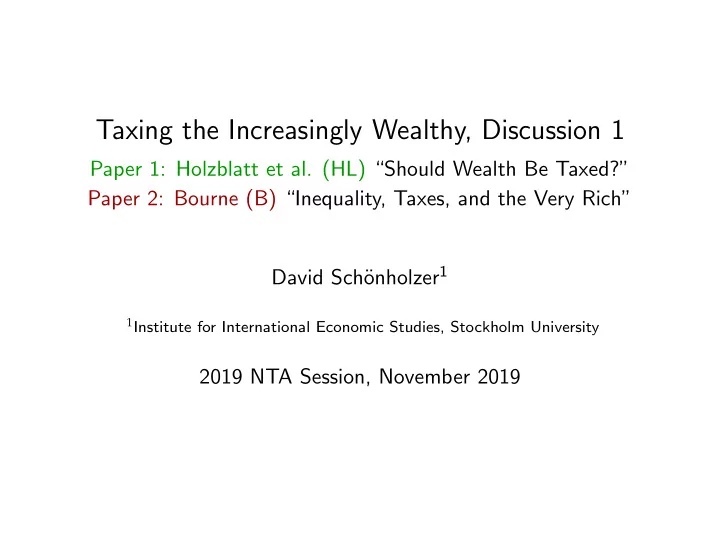

Taxing the Increasingly Wealthy, Discussion 1 Paper 1: Holzblatt et al. (HL) “Should Wealth Be Taxed?” Paper 2: Bourne (B) “Inequality, Taxes, and the Very Rich” onholzer 1 David Sch¨ 1 Institute for International Economic Studies, Stockholm University 2019 NTA Session, November 2019
Issues Surrounding Taxing the Wealthy 1 How much wealth is out there? HL, B • Data measurement problem: who, what, how is missing? • Question about quality of imputation 2 What statutory rates should be paid on it? HL, B • Tax apportionment and normative policy question • Depends on mechanical and behavioral responses 3 What effective rates are paid on it? HL, B • Avoidance and evasion behavior • Norms and institutions 1 / 4
1 How much wealth is out there? • Data sources: strengths and weaknesses • IRS Public Use File HL, B • Survey of Consumer Finances HL • Forbes list HL • IRS linked estate tax / income tax data B • Imputation methods, representativeness • TPC Microsimulation Model HL • Sample weights and near-universe of (reported) wealth B • Is there a “ground truth”? What is un/misreported? HL • The Big Four? • JPMorgan, BofA, HSBC, etc? (Artavanis et al. 2016) • Picassos in basements? 2 / 4
2 What statutory rates should be paid on wealth? • Asset classes and portfolio composition determine rates • Policy debate: Warren versus Booker • Warren: inequality problem and social programs • Booker: “cumbersome, tried by others, hard to evaluate” • Academic debate: what tax instrument most effective? HL • Estate, capital gains, property taxes: existing wealth taxes B • “Direct” wealth tax: • Efficiency cost? B • Implementation uncertainties? HL • Allows to tax unrealized capital gains? 3 / 4
3 What effective rates are paid on wealth? • Avoidance & evasion: from Sweden (0.1) to Switzerland (43) • What determines elasticity? Proximate factors 1 Research design: DiD vs bunching, static vs dynamic HL 2 Tax competition and migration HL 3 Evasion tolerance and exemptions/deductions/breaks B • Ultimate factors driving elasticity: 1 Norms: attitudes of leaders and tax payers 2 Institutions: state capacity (Besley & Persson 2009) 3 Government efficiency (Alesina et al. 2018) 4 / 4
Recommend
More recommend